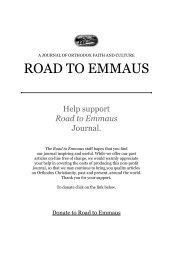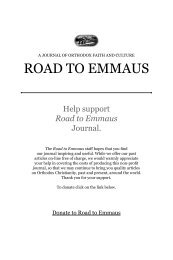RTE No 20 Interior - Road to Emmaus Journal
RTE No 20 Interior - Road to Emmaus Journal
RTE No 20 Interior - Road to Emmaus Journal
You also want an ePaper? Increase the reach of your titles
YUMPU automatically turns print PDFs into web optimized ePapers that Google loves.
<strong>Road</strong> <strong>to</strong> <strong>Emmaus</strong> Vol. XII, <strong>No</strong>. 2 (#45)CROAGH PATRICKold children’s burial ground next <strong>to</strong> it, overlooking the ocean. St. Cailín wasthe brother of MacDara and MacDuach. Even <strong>to</strong>day the local boatmen venerateMacdara as the “Fisher MacDara” by dipping their sails three times asthey pass the island. This is a tradition not from his<strong>to</strong>ry as we think of it, butfrom folklore, which is a parallel source of information. There is a beautifulpilgrimage on the 11th of <strong>No</strong>vember with dancing and sometimes a boatrow or a regatta. Right out from Cailín’s Well is Chapel Island, with an 11thcenturymedieval church. So, the three pilgrimages of Mám Ean, MacDara’sIsland and St. Cailín’s Well are the three in this part of Connemara.Just north of us is a pilgrimage on the Feast of the Assumption, the 15th ofAugust, <strong>to</strong> Caher (Fortress) Island, where there is a wonderful local pilgrimage<strong>to</strong> an abandoned monastic site. We think that this was once the endpoin<strong>to</strong>f a much larger pilgrimage with many s<strong>to</strong>ps that started in the center ofMayo at an early church site called Ballintubber Abbey and stretched westwardacross a wonderful sixty mile transect of the Irish landscape, of whichCroagh Patrick is a sort of ritual centerpiece. From Croagh Patrick, the pilgrimscontinued westward <strong>to</strong> Kilgeever, another church site, and onwards <strong>to</strong>Caher Island, owned by the people of Inishturk, where they hold one of themost beautiful maritime sea pilgrimages in Ireland, mostly attended by thepeople of Southwest Mayo, Inishturk, Inishbofin, Clare Island and the RenvylePeninsula. I attended the pilgrimage on the 17th of August <strong>20</strong>10 alongwith almost 500 other people, the largest attendance in its modern his<strong>to</strong>ry.Climbing Croagh PatrickThe most important regional pilgrimage site, of course, is Croagh Patrick.This is very much a rural pilgrimage that still survives among small farmers—people with deep old values, an earthy sort of people who may not be regularmass goers, but they wouldn’t miss Croagh Patrick. Very little researchhas been done on this pilgrimage, because although Irish academics mightbe Catholic, they aren’t part of the rural pilgrimage scene and have neverbothered <strong>to</strong> study it. Even with the general decline of religious vocations andchurch attendance, rural pilgrimage is still very strong in Ireland, and here inConnaught, the attendance at Sunday mass is still high, probably over 60%.As St. Patrick is our national saint, any site associated with him has a highstatus, and Croagh Patrick is a beautiful, iconic mountain. Pilgrims comehere from all over Ireland, but mostly Connaught and Ulster, the westernand northern provinces. The original Patrician heartland, of course, was Ulster,which, as far as we know was where Patrick came in the fifth century,captured on a raid when the Irish expanded eastward in a brief imperiousburst and brought captured Christian slaves back with them. Patrick is creditedwith founding a whole series of churches in East Ulster. Croagh Patrickpersists as a major church site and has been so throughout the centuries.Croagh Patrick (which we call “The Reek” colloquially, a reek being a steepsidedstack of turf) is partly owned by the farmers around it, but much of itbelongs <strong>to</strong> the Archbishop of Tuam, the patron of our pilgrimage. Tuam is ourbig diocese founded by St. Jarlath in the 6th century. Although it is a small<strong>to</strong>wn now, in the times of the early church, it was a very large and importantmonastic centre, and Jarlath is still a common first name in this area.<strong>RTE</strong>: What do you remember of your first climb up Croagh Patrick?MICHAEL: Climbing the Reek in 1974 was my first experience of a mountainpilgrimage. It was an amazing night: a whole gaggle of teenagers leavingClifden, where the buses converged after the pubs closed (the traditionaltime for starting out). Most people didn’t have a car so they travelled fromall over on buses. We s<strong>to</strong>pped <strong>to</strong> pick up pilgrims in villages all along the wayand by the time we got <strong>to</strong> Westport, we were part of a throng of literally tensof thousands of people.Climbing the Reek is still done by a whole cross-section of people, fromthe very young <strong>to</strong> the very old. You’ll get children as young as three up CroaghPatrick, all the way <strong>to</strong> the <strong>to</strong>p. Sometimes they’re dragged crying andscreaming, sometimes they’re way ahead of Mom and Dad. You also haveparents and grandparents, whole extended families going up. You’re part ofa much wider community and that’s what gets most people <strong>to</strong> the <strong>to</strong>p. It’squite an arduous climb when you’re not experienced and most people aren’thill walkers, they don’t have proper gear, they don’t often have raincoats.(You know Irish people still haven’t adapted well <strong>to</strong> our weather. When therain comes, we’re always surprised—we’d be extinct in any other climate).But there’s an extraordinary excitement about the climb because you’remeeting people you may not have seen for a whole year. It’s a great time ofpeople pulling <strong>to</strong>gether.<strong>RTE</strong>: Why did you climb it?67










